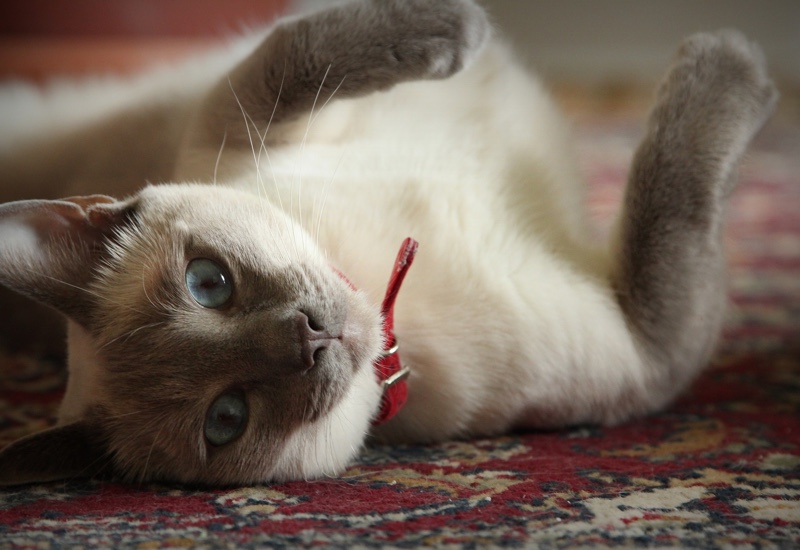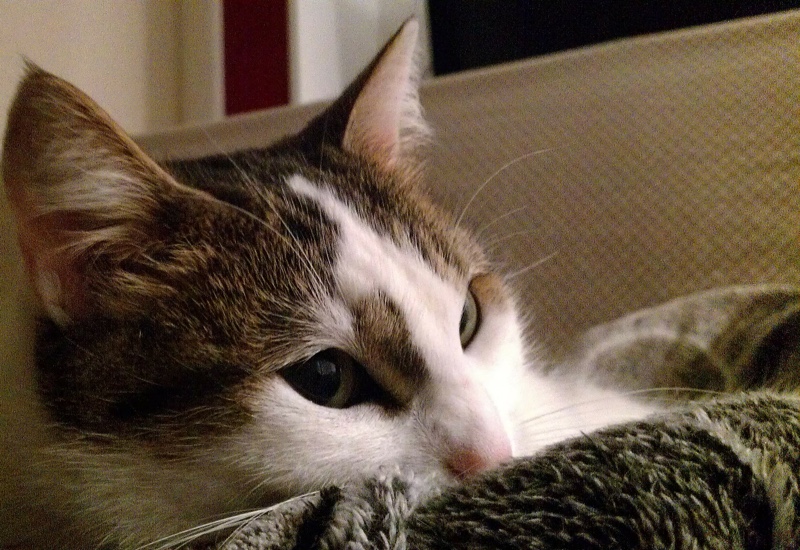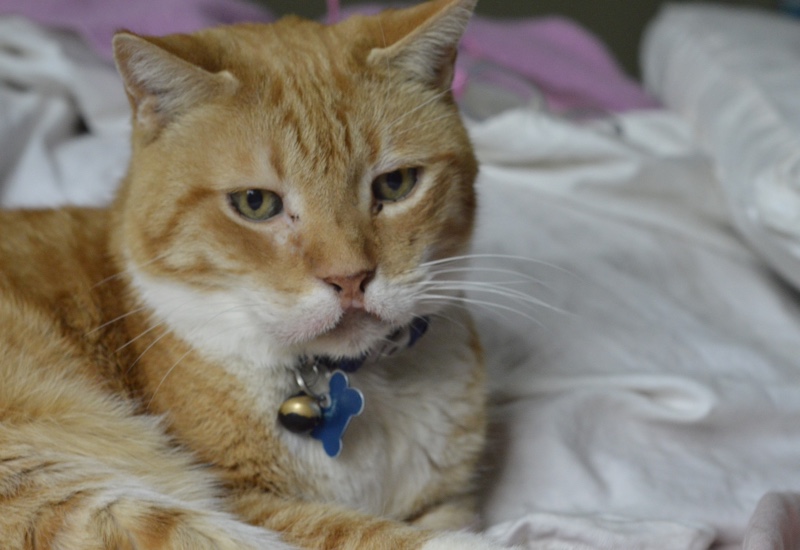5 Fun Tricks to Teach Your Dog
You can teach dogs of any age new tricks. Get a full how-to for these easy routines.
Has your feline come down with a case of the itchy-scratchies? A feline who is incessantly scratching, rubbing, chewing, or licking may be suffering from one of these common skin conditions in cats. Read on to see what all that scratching could be about.
Some of the most noticeable signs of skin issues in cats are how a cat responds to the affliction. These can include excessive licking, rubbing against carpeting or furniture, pawing at the ears and mouth, and chewing at the skin. You may also notice signs such as:
The signs can vary depending on what’s causing the condition. Different skin issues can also have similar symptoms, so you should contact your veterinarian when you first notice the problem. Your veterinarian can help accurately diagnosis the issue and recommend an effective treatment.
Keep in mind that cats are notorious for hiding or masking signs of a condition or illness. Even if cats are itchy, they might wait until their cat parents leave the house or seek out private spaces to satisfy that itch. You can watch for these 5 signs your cat is sick, and be sure to visit your veterinarian for annual exams.
Those annual exams are really important for cats, but unfortunately, many felines don’t get to the veterinarian regularly. Regular visits can help to identify issues like skin conditions early before they turn into bigger problems. If you’re not taking your cat to the veterinarian for financial reasons, you should consider cat insurance. A plan with wellness coverage can help you cover the costs of routine preventive care.

If your cat is showing signs of a skin condition, one or more of these problems could be the reason.
Like dogs, cats are prone to picking up these pesky little bugs. Even cats who only stay indoors can get fleas from other pets who are in the home. The fleas themselves can be irritating plus their bites can cause an allergic reaction and lots of itching in some cats.
If you suspect your cat has fleas, look over the skin and fur over carefully. Fleas seek out warm spots and may be more likely to hang out at the base of the ears or near the rear, but they can be anywhere on your cat. Here’s how to check for them:
One trick is to brush your cat over a sheet of white paper. Try dampening any small specks that appear with a bit of water. If the spots turn red, it could be a sign of flea feces. The crimson color is a result of the blood consumed by the little pest.
It’s important to note that cats can be very sensitive to flea products. Be sure to talk to your veterinarian before using any over-the-counter remedies. This holds true if you have a dog with fleas in the home. Even if your cat hasn’t contracted the fleas, you should be careful with the flea products you choose for your dog.
Ringworm is actually caused by a fungus and not a worm. The ring in the term refers to the circular marks that form on the skin when an infection occurs. Ringworm is very contagious and can spread through spores on the fur or in the air. Be sure to separate any afflicted cats or dogs from other pets in the home. Very young and older cats, as well as cats with health issues, can be more susceptible to ringworm.
This fungal infection is not a pretty sight. When a cat has ringworm, you might see bald patches, crusty or scaly skin, and inflammation around the rings. If your cat has ringworm, see your veterinarian who may prescribe an anti-fungal treatment.
You should also wash and disinfect any bedding, blankets or other areas where your cat has spent time to ensure that the fungus and its spores don’t stick around. If your cat has long hair, it can be helpful to give him or her a trim to help remove spores.
According to the ASPCA®, the spores of this fungus can be killed with common disinfectants like chlorine bleach diluted 1:10 (1/4 cup in 1 gallon of water), benzalkonium chloride, or strong detergents. But, never mix cleaning products. This may cause harmful gases.
Cats can be sensitive creatures and may have or develop allergies over the course of their lives. Cats can be allergic to many different things, including pollen, shampoos, household cleaning products, perfumes, cigarette smoke, a variety of foods, and fleabites.
If you suspect your cat has an allergy to something, you can work with your veterinarian to help identify the allergen. Once you know what’s causing the allergy, you can try to avoid exposing your cat to the offending substance. Of course, this might not be entirely possible depending on the allergen.
In some cases, medication such as an antihistamine can be useful. But please remember never to give your cat any medication without talking to your veterinarian first. Human medication can be especially harmful to cats, and it consistently tops the list of the 10 most common pet toxins compiled by the ASPCA Animal Poison Control Center (APCC).*

These little parasites can be very irritating and cause cats to shake their heads and paw at their ears. Sometimes all of that pawing can pull out the hairs around the ears and result in bleeding. You may also notice debris around the ear as well as small, dark bumps in the ear canal.
Fortunately, your veterinarian can typically treat ear mites fairly easily by cleaning the ears and prescribing special drops. These drops usually need to be given for about a week or so to eliminate the mites. Ear mites are contagious, so be sure to have any other pets in the house checked out.
Ear mites are actually one of several types of mange or parasitic mites that can affect cats. Another type is Notoedric Mange, which is also called feline scabies. It’s similar to sarcoptic mange or canine scabies in dogs (see Common Skin Problems in Dogs). Feline scabies is rare but highly contagious. If you suspect your cat has mange, visit your veterinarian to figure out exactly what’s going on and get a recommendation for an appropriate treatment.
This may surprise you, but cats can get a form of acne. Feline acne appears as little blackheads on a cat’s face and chin. Although this breakout won’t ruin the school dance, it can be quite annoying for the cat.
Cats with feline acne may rub their faces along the carpet to try to relieve the irritation. Left untreated, feline acne can cause a bacterial infection, which may require antibiotics.
When you notice a lump in your cat’s skin, the first thing that might come to your mind is cancer. However, not all lumps are cancerous. For instance, the lump may be a cyst or a non-malignant tumor.
You should have your cat checked out by your veterinarian to examine the lump and, if necessary, perform a biopsy to see if it is malignant. The lump may need to be removed, and in some cases, this may be the only treatment necessary. If it’s cancerous, your cat may need treatment that could include radiation and chemotherapy.
Did you know that a plan from ASPCA Pet Health Insurance can help cover cancer treatments, including chemotherapy? Learn about a plan for your cat.
Cats can get dry skin like we do, particularly in climates with low humidity or during the winter when the heat is running and drying out the air. Dry skin can also be caused by nutritional issues, such as dehydration or a lack of healthy fats in the diet. Ask your veterinarian for advice on how much water your cat should be drinking and healthy food choices.
Cats can suffer from a number of skin infections, such as yeast infections or feline military dermatitis, which can result from allergens such as fleas. Cats with other health issues like diabetes can be more likely to suffer from a skin infection.
Cats with skin infections tend to overgroom to try to relieve the itching and irritation. If you start noticing excessive grooming, bald spots, or matted fur, you should contact your veterinarian to see what could be going on for your cat.

Skin issues can indicate an underlying ailment, which is why it’s important to have your cat checked out by your veterinarian. If your cat has an illness, the skin condition is not likely to improve until the sickness is properly managed or cured.
Cat insurance can help you manage the costs of treatment for skin issues, including underlying illnesses. A cat insurance plan can also help you manage expenses for unexpected accidents—which can happen to indoor only cats too! Find out what you should know about cat insurance.
*10 Most Common Pet Toxins of 2014 as reported by the ASPCA Animal Poison Control Center